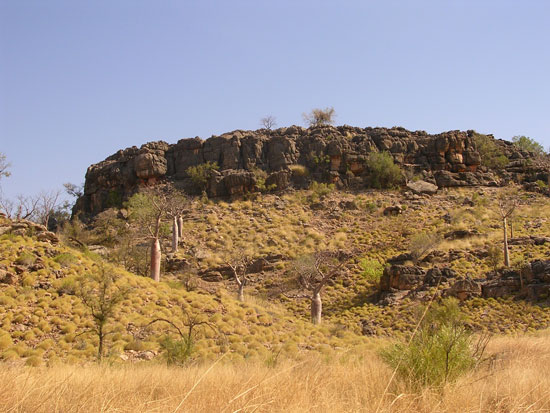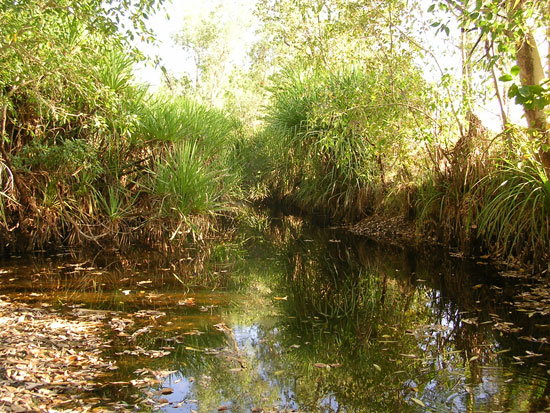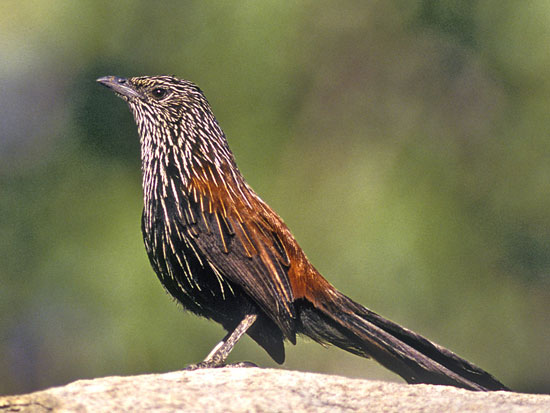What’s at Stake? The Kimberley Environment
The Kimberley is a vast and very sparsely populated region of Australia. The landscape of the region is as immense as it is beautiful. Despite its vast natural wonders, there is much of the Kimberley flora and fauna which remains unexplored and little understood.
The Kimberley is home to thousands of plant and animal species, many of them highly restricted or specialised, whilst some are threatened, vulnerable or endangered. Put simply, there remains so much to learn about the region that nobody can claim that bringing heavy industry into the region will not be forming a threatening process.
Basic geology – a mix of the most ancient and modern

Sandstones, mudstones and siltstones dominate the Broome and Dampier Peninsula region. Image © 2007 Ricki Coughlan. Press image for enlargement.
The Kimberley can be divided into two regions: the Northern Kimberley, which can be described as a plateau, and the Central Kimberley, which is frequently hilly to mountainous with a series of parallel siliceous ranges. Broadly, the Kimberley geology is comprised of Proterozoic sedimentary and igneous rocks (1.7 – 2 billion year old rocks formed prior the appearance of life on earth) and skeletal sandy soils of the Cainazoic (recent deposits). ¹
A large portion of the western Central Kimberley landscape is dominated by significant limestone depositions, formed during the construction of a large reef in the late Devonian.
The Broome/Dampier Peninsula region geology consists of sandstones, siltstones and mudstones overlaid with extensive reddish sandy plains. Most of the exposed sandstones are of the late Jurassic or early Cretaceous (150 – 120 mya) and contains numberous fossil marine shells³ and, famously, a number of dinosaur footprints.
Vegetation

Spinifex and tussock grasses near Tunnel Creek. Image © 2007 Ricki Coughlan. Press image for enlargement.
The sandy soils of the Central Kimberley support a variety of hummock (Triodia spp.) and ribbon grasses (Chrysopogon spp.) with scattered savannah woodlands. Open forests of River Red Gum (Eucalyptus camaldulensis) and Pandanus spp. occur along watercourses. In the western part of this region (Broome and Dampier Peninsula), a large variety of Acacia spp. dominate dense and complex coastal scrub, interspersed with coastal vine scrub, savannah woodlands, saltmarsh and open grasslands.
The Northern Kimberley is covered with savannah woodlands comprised of Woollybutt (E. miniata), Grey Box (E. tectifica) and Darwin Stringybark (E. tetradonta) over high Sorghum grasses (Plectrachne schinzii) and hummock grasses where shallow sandy soils dominate. Watercourse vegetation is often comprised of paperbark and Pandanus and extensive mangrove forests occur along sheltered bays and estuaries. Many patches of monsoon rainforest and vine thickets are scattered in the region. ¹

Restricted and Threatend Pandanus lined watercourses like this are home to Vulnerable populations of Purple-crowned Fairy-wrens. Image © 2005 Ricki Coughlan. Press image for enlargement.
Ecosystems at risk
Nine ecosystems are considered to be at risk in the Central Kimberley. These include tropical and sub-tropical rainforest, tropical forests and woodlands, paperbark forests and woodlands, herbland, sedgeland and rushland and freshwater lakes. Most pressure comes from grazing, weeds and changed fire regimes.
In the Northern Kimberley, three Threatened Ecological Communities are declared Vulnerable under WA legislation: Walcott Inlet and Roe River Rainforest Swamps and Theda Soak Rainforest. Fifteen other ecosystems have been identified as being ‘at risk’. They include tropical and sub-tropical rainforest, tropical forests and woodlands, paperbark forests and woodlands and herbland, sedgeland and rushland. Most are in fair condition, and declining or static. The main threats are grazing pressure and changed fire regimes. ¹
Species at risk

Iconic and Vulnerable, the Purple-crowned Fairy-wren is restricted to watercourses. Image © 2004 Chris Ross. Press image for enlargement.
In the Central Kimberley, under WA State legislation, 2 plant species, 3 mammals, 2 birds and 5 reptiles are declared as vulnerable, 1 bird and 1 reptile are declared as endangered, 42 plants are listed as either priority one or priority two, and 1 plant and 2 mammals are declared rare. The Commonwealth lists 2 birds and 2 turtles as endangered, and 3 birds, 4 turtles and 3 mammals as vulnerable.
In the Northern Kimberley, under WA State legislation, 1 bird and 2 mammals are listed as Endangered, 2 birds declared as Vulnerable, one mammal and one plant are declared rare and 16 plants as either priority one or priority two. One bird is listed as endangered and three birds vulnerable by the Commonwealth.
The threatening processes for individual vertebrates are poorly understood or unknown, although changed fire regime is considered to be the main threatening process for the Gouldian finch. The trend in the condition of all species is mostly unknown, as are threatening processes for the plants. ¹

Black Grasswrens are rare and restricted – mostly to sandstone habitat on the Mitchell Plateau. Image © 2008 Graeme Chapman. Press image for enlargement.
Plants and animals can also be under threat if their range or habitat is highly restricted. The Kimberley region holds a great many species of this sort, including the Black Grasswren, White-lined Honeyeater, Variegated Fairy-wren race (Malurus lamberti rogersi), Ninbing False Antechinus, Butler’s Dunnart, Golden Bandicoot, Scaly-tailed Possum, Monjon, Golden-backed Tree Rat, Kimberley Rock Rat and perhaps the Kimberley Cave Bat. The Buccaneer Burrowing Skink along with agamids (dragon lizards) Diphoriphora convergens and Diphoriphora superba are also highly restricted within the Kimberley. Restricted snake species include Ramphotyphlops howi, R. kimberleyensis, R. troglodytes, R. yampiensis (known only from Koolan Island), Rough Scale Python (Morelia carinata) and Worrell’s Snake (Simoselaps minimus)².
Rare, iconic, threatened and endangered
The Kimberley holds a great many rare, threatened and endangered species. Some of these, such as the Gouldian Finch, are global icons of nature. These species are insufficiently understood for anyone to claim that development can take place in their region at no risk to them.
-
View a list of species at risk in the Northern Kimberley
-
View a list of species at risk in the Central Kimberley
Sources:
¹ Australian Natural Resources Atlas, Australian Government.
² Kimberley Development Commission.
³ KF Kenneally, DC Edinger, T Willing. Broome and beyond, plants and people of the Dampier Peninsula, Kimberley, Western Australia. CALM, 1996









